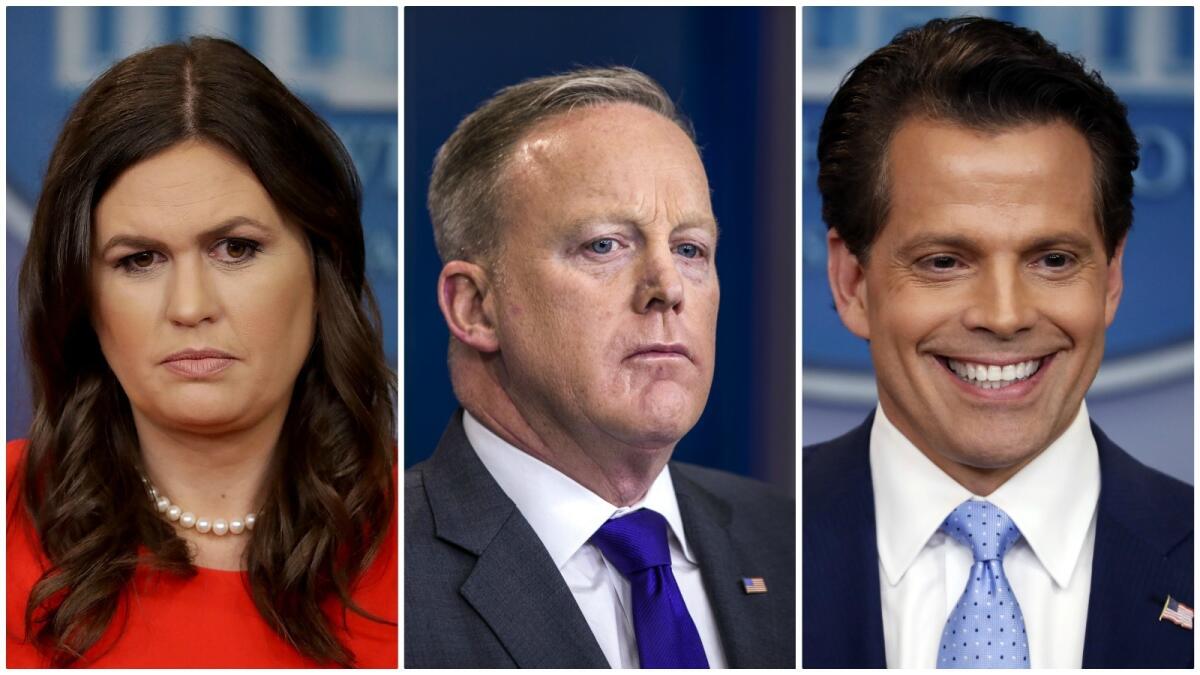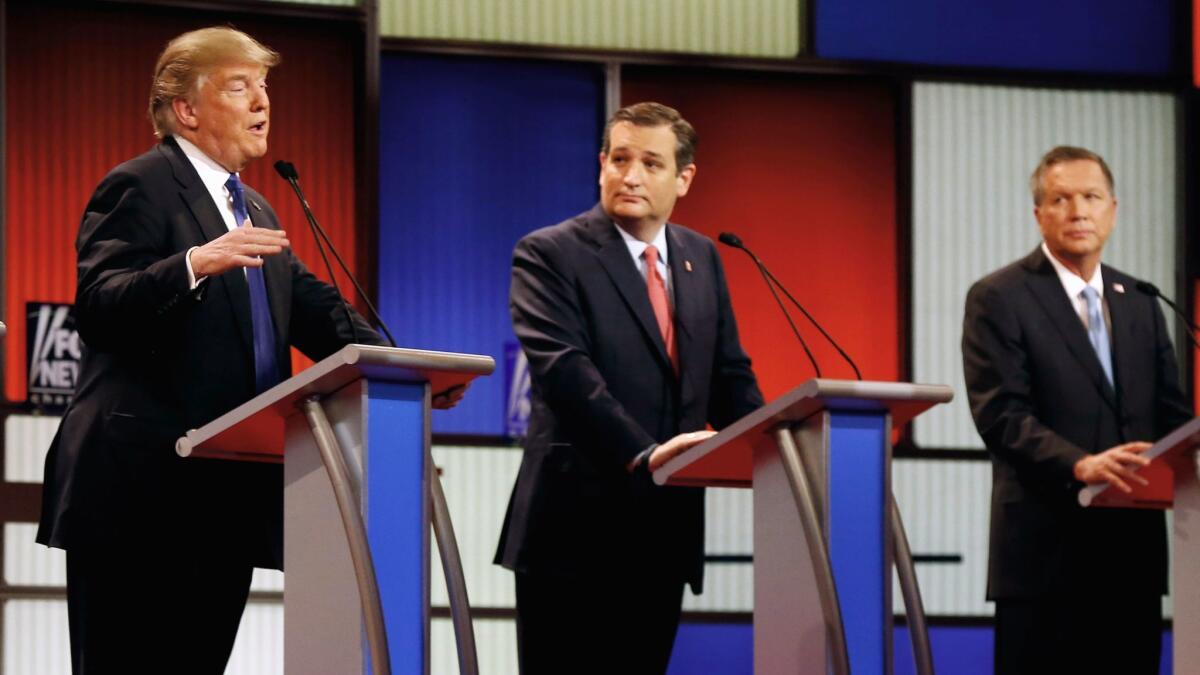Has the Trump presidency permanently changed how the media cover the presidency?

- Share via
Quick quiz: Name just one press secretary or director of communications who served under President Obama or George W. Bush.
If you’re Googling for answers, congratulations, and condolences: You’re no different than most Americans.
Now ask yourself the same question about President Trump’s administration. It’s likely you’re rattling off names as spontaneously as a freestyle rapper: Spicer, Scaramucci, Huckabee Sanders.
Drop the mike. Take a victory lap. All those hours of flipping among CNN, MSNBC and Fox, watching wall-to-wall coverage of the Trump White House and everything that touches it, have finally proved useful. Addiction has it rewards.
And make no mistake, watching cable news is no longer just a casual pastime or a way to stay informed. It’s an addiction, an American epidemic that started with a gateway drug known as the Trump presidency.
Checking in with first-name commentator anchors like Anderson, Rachel or Tucker for the latest developments, drama and crises emanating from the White House is now habit, like checking your smartphone for messages, after you just checked it two seconds ago, after you just checked it three seconds before that.
And most of what we’re getting is opinion. The phrase “let’s ask the panel” has become the mantra of the 24-hour news cycle — Trump just tweeted threats to North Korea, let’s ask the panel; the Russia probe is looking into Trump family connections with Moscow, let’s ask the panel.
Pundits may argue that President Trump hasn’t accomplished much in his first six months in office (no Obamacare repeal, no Hillary incarceration, no wall other than the one Atty. Gen. Jeff Sessions bangs his head on nightly), but the Showman Trump has turned cable news into a must-see spectacle that’s hard to resist.
His lasting influence could very well be altering the way in which we consume politics and news, turning coverage of how the nation is governed into a talk show about an unhinged reality show. To quote a phrase popular with the president: It seems we’ve “crossed the red line” for how we ingest news, and it’s unlikely we’ll ever be able to turn back to simpler times, when Senate hearings were C-Span fodder and press briefings an exercise in protocol.
Americans have come to rely on the continuous feed of wacky, sad and terrifying White House moments for entertainment.
Americans have come to rely on the continuous feed of wacky, sad and terrifying White House moments for entertainment, even if the ultimate effect jangles nerves and overloads synapses.
When Sean Spicer resigned six months into Trump’s presidency, you could almost hear the collective disappointment — “Awe. Spicey’s out! Who and what are we going to watch next? Will they be as entertaining and outlandish?” Enter Scaramucci. Hooray! Next.
The news machine is hooked on Trump’s superlatives, which are more Barnum & Bailey circus barker (“Like the World Has Never Seen!”), John Wayne (“Locked and Loaded!”) and Cersei Lannister (“They’ll be Met With Fire and Fury”) than presidential.
“What Trump Said” and “Words Matter” were the taglines that flashed on the screen during an hour of panelist prattle devoted to Trump talk last week on prime-time CNN. Everyone from the network’s outspoken star commentator Ana Navarro to former Defense Secretary William Perry to Trump biographer Michael D’Antonio deconstructed POTUS’ ultimatums to Kim Jong Un, Trump’s threat of military intervention in Venezuela, his taunting of Senate Majority Leader Mitch McConnell (give this to Trump: He’s an equal opportunity mocker; Republicans feel it as much as Democrats).
Absent from broadcasts: Actual reportage on real news, especially if it doesn’t directly concern Trump or the partisan warfare that’s distorted our world view. Even when there is real news — like the horrific violence spurred by white supremacists in Charlottesville, Va. — it’s subsumed by angry debates about what the president should have said and the frightening foothold the alt-right has gained in our nation. Lots of sound and fury to be sure, but not much significance.
All Trump talk, all the time, is a ratings bonanza. Cable’s three major news networks saw double-digit ratings growth in the second quarter of this year. MSNBC’s “The Rachel Maddow Show” and “Last Word With Lawrence O’Donnell” are up 86% in prime-time viewership compared with the same period in 2016.
CNN saw a 39% leap in viewers ages 25 to 54, and that’s after having its most-watched first quarter in 14 years. Even Fox News, which took major hits the last year with the loss of founder Roger Ailes and its star host Bill O’Reilly, saw record numbers for daytime viewership for any cable news network.e highest-rated quarter of total day viewership
So why would they ever go back to old-fashioned “boring” coverage? And would that satisfy the need for our hourly political fix?
The wall-to-wall coverage we’ve come to expect now didn’t start with the inauguration in January. It’s been unprecedented drama all the time for the last two years, ever since Trump threw his hat in the ring for the presidency.

The GOP primary debates, not formerly thought of as audience bait, all of a sudden became must-see Saturday night viewing. “Lyin’ Ted” and “Little Marco’s” campaign rallies were hard to find between footage of Trump’s every move — bashing Mexican immigrants, Gold Star families and former beauty pageant contestants on the campaign trail, hair blowing in mysterious ways on the tarmac, bragging of grabbing and kissing women against their will in old leaked “Access Hollywood” footage.
His outrageous comments about Sen. John McCain (not his kind of hero) or threats to jail his opponent (“Lock her up!”) and behavior assured he’d never win. But, wow, was it entertaining. Things were supposed to return to their usual mix of semi sober news coverage and liberal versus conservative commentary when the favored opponent won. And then something funny happened on the way to the polls ….
Americans, apparently, wanted more of the show.
Trump brought the nexus of reality show entertainment, cheap tabloid scandal and the idea that a presidency should be Nielsen rated with him to the White House. The news media responded the way they often do to sensational events — with nonstop coverage.
The Trump presidency became the new Malaysian Airlines disappearance, or Ferguson uprising, or balloon boy story, stretched out over what now feels like 1,000-years worth of CNN “Breaking News!” banners.
And we can’t turn away.
On any given hour, CNN will feature a panel of up to 10 talking heads that includes a mix of their own reporters, former Washington types — Paul Begala, David Gergen, Jim Acosta, Van Jones, Gloria Borger, David Axelrod, Dana Bash — and those with strong opinions on both sides, like the vehemently anti-Trump Van Jones and the equally fervent pro-Trump Jeffrey Lord (at least until he was fired by CNN this month for using a Nazi slogan on social media).
Whether the subject is the Russia investigation or healthcare or what’s behind Jared Kushner’s sunglasses, it kicks off with a short “report” and then back to the panel for an hour-long dissecting session. This might not be a good era for journalists, but it’s a boom time for commentators who like to mix it up.
So what’s happened to the rest of the “real” news in all of this — earthquakes, regional wars, major crimes, goats stuck in a well? The answer is that, despite wall-to-wall “news” coverage, it’s harder and harder to find — even online.
It takes a serious deep dive into regional outlets, social media and European platforms to get past the seemingly impenetrable wall of the same 10 Trump-related stories on loop. That’s assuming the news is in fact real and not fabricated in Kiev or the basement of a fabricator for hire.
But when the broadcast is focused on such a small slice of the news cycle, filtered through commentary, can it be called news at all? Seasoned broadcast veterans even seem trapped in the hall of mirrors where opinion of the news is driving the cycle, not the events themselves.
Recently when MSNBC anchor Ali Velshi had to pivot away from the usual menu of talking points to read a report on the mood in Guam after threats of a nuclear attack on it made by North Korea, he apologized to his guest for “having to keep our eye on more than one story.”
It’s not Ali’s fault. It’s our collective ADD, our obsession with what’s next. One pundit called it the Scaramucci Cycle — a machine on perpetual spin.
And much of it is taken in by already partisan viewers. Want to find out how rotten Trump really is? Four hours of MSNBC at night will do it. Want to know that the FBI investigation of his administration is a hoax and distraction? Then just tune in to Fox any time of day. The network will tell you what you want to hear to stay outraged, placated or justified.
There is one common refrain among networks though, regardless of the slant: The idea that our politics are broken, people don’t believe in institutions anymore, the country is on the wrong path. The sad irony is that this coverage, and our addiction to it, may do more to undermine our faith in all this than anything happening in Washington.
Twitter: @LorraineAli
ALSO
Fox CEO James Murdoch criticizes Trump over response to Charlottesville
Members of White House arts panel resign to protest Trump comments
President Obama often spoke about race relations in the U.S. Here are some of his words
More to Read
The complete guide to home viewing
Get Screen Gab for everything about the TV shows and streaming movies everyone’s talking about.
You may occasionally receive promotional content from the Los Angeles Times.







